Construction Equipment and Operations: Automation and Robotics Report
VerifiedAdded on 2019/09/16
|17
|4010
|127
Report
AI Summary
This report delves into the increasing integration of automation and robotics within the construction industry, examining its impact on equipment and operations. It begins by outlining the necessity of automation in construction, highlighting the benefits of computer-aided control and supervision in managing costs and reducing risks. The report then explores specific technological advancements, such as robotic automation in masonry production and prefabrication, detailing how robots are utilized in various stages of construction, from material placement to structural assembly. It also discusses the incorporation of these technologies into the industry, emphasizing the importance of design flexibility and information technology integration. The report further analyzes the benefits of automation, including increased efficiency and reduced manpower requirements, while also addressing current limitations and potential risks. Finally, it proposes potential future developments in the field, offering a comprehensive overview of the evolving landscape of construction equipment and operations.
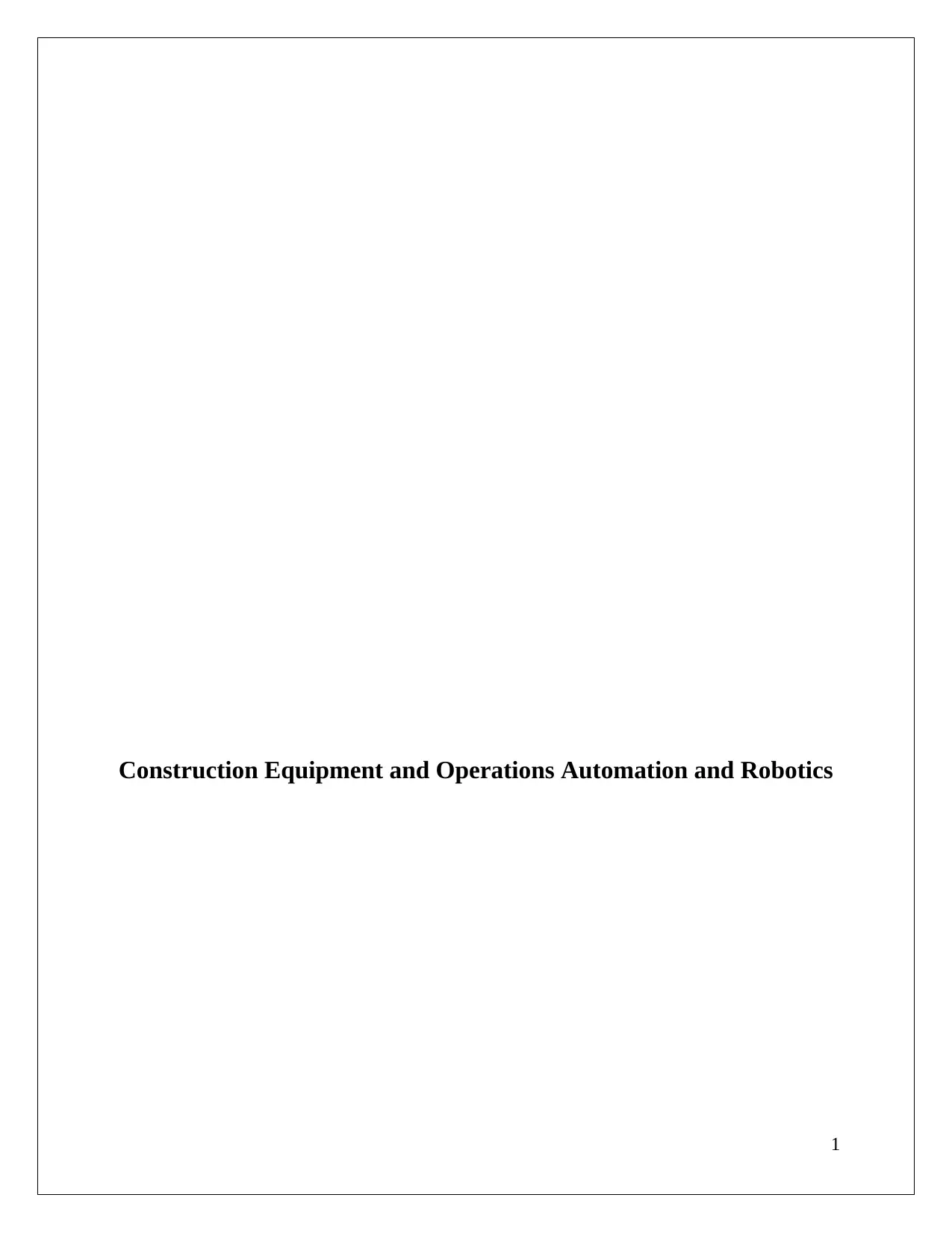
Construction Equipment and Operations Automation and Robotics
1
1
Paraphrase This Document
Need a fresh take? Get an instant paraphrase of this document with our AI Paraphraser
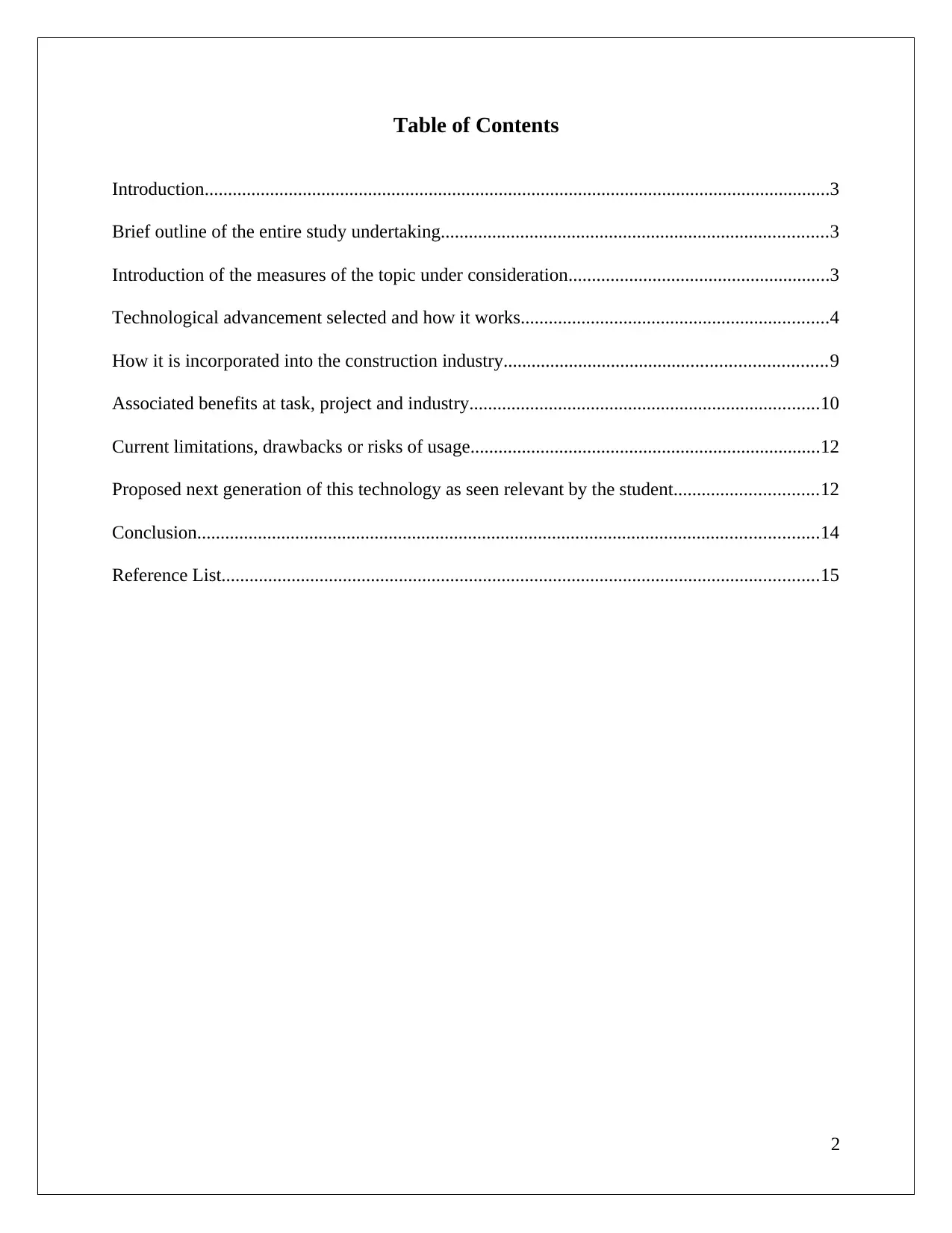
Table of Contents
Introduction......................................................................................................................................3
Brief outline of the entire study undertaking...................................................................................3
Introduction of the measures of the topic under consideration........................................................3
Technological advancement selected and how it works..................................................................4
How it is incorporated into the construction industry.....................................................................9
Associated benefits at task, project and industry...........................................................................10
Current limitations, drawbacks or risks of usage...........................................................................12
Proposed next generation of this technology as seen relevant by the student...............................12
Conclusion.....................................................................................................................................14
Reference List................................................................................................................................15
2
Introduction......................................................................................................................................3
Brief outline of the entire study undertaking...................................................................................3
Introduction of the measures of the topic under consideration........................................................3
Technological advancement selected and how it works..................................................................4
How it is incorporated into the construction industry.....................................................................9
Associated benefits at task, project and industry...........................................................................10
Current limitations, drawbacks or risks of usage...........................................................................12
Proposed next generation of this technology as seen relevant by the student...............................12
Conclusion.....................................................................................................................................14
Reference List................................................................................................................................15
2
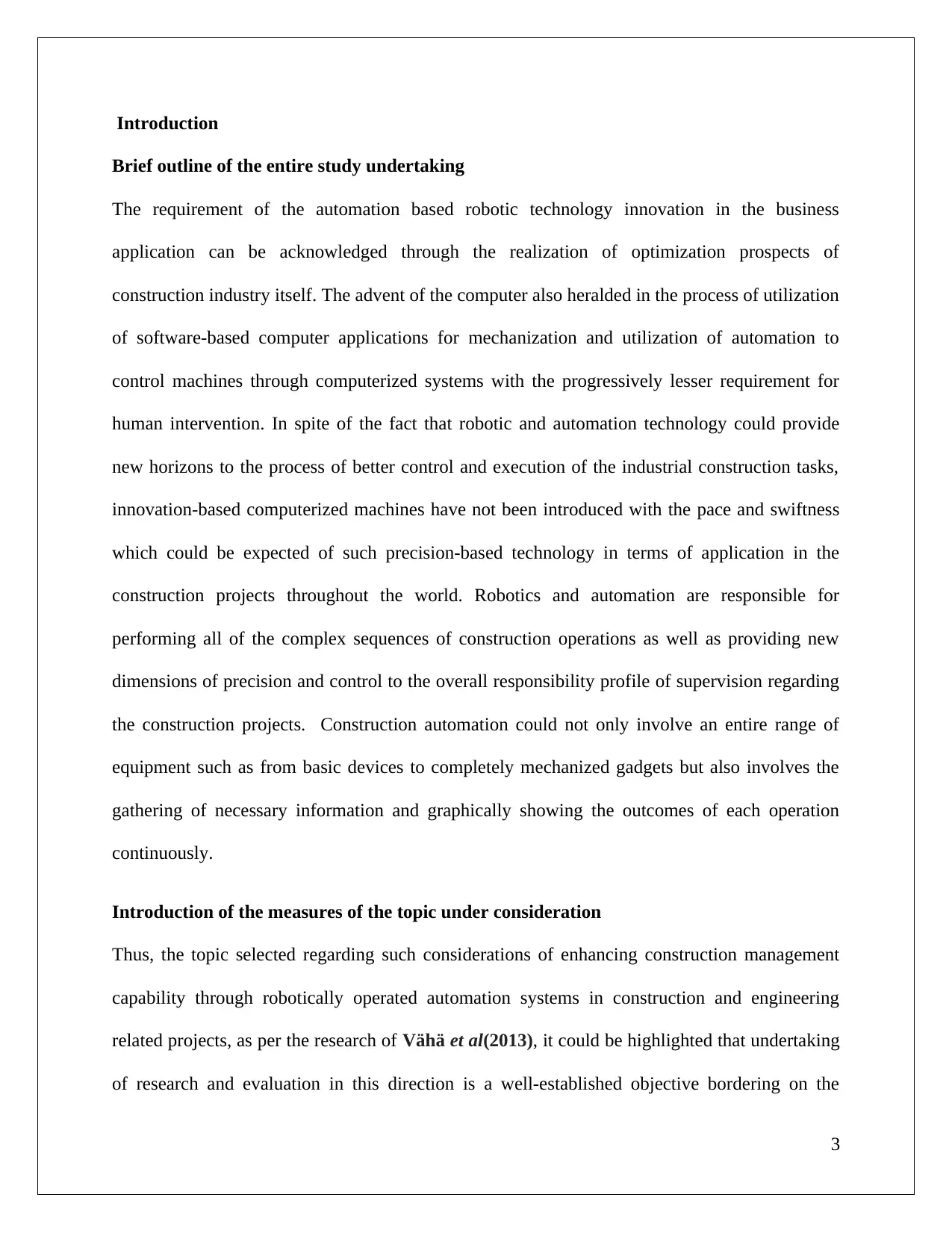
Introduction
Brief outline of the entire study undertaking
The requirement of the automation based robotic technology innovation in the business
application can be acknowledged through the realization of optimization prospects of
construction industry itself. The advent of the computer also heralded in the process of utilization
of software-based computer applications for mechanization and utilization of automation to
control machines through computerized systems with the progressively lesser requirement for
human intervention. In spite of the fact that robotic and automation technology could provide
new horizons to the process of better control and execution of the industrial construction tasks,
innovation-based computerized machines have not been introduced with the pace and swiftness
which could be expected of such precision-based technology in terms of application in the
construction projects throughout the world. Robotics and automation are responsible for
performing all of the complex sequences of construction operations as well as providing new
dimensions of precision and control to the overall responsibility profile of supervision regarding
the construction projects. Construction automation could not only involve an entire range of
equipment such as from basic devices to completely mechanized gadgets but also involves the
gathering of necessary information and graphically showing the outcomes of each operation
continuously.
Introduction of the measures of the topic under consideration
Thus, the topic selected regarding such considerations of enhancing construction management
capability through robotically operated automation systems in construction and engineering
related projects, as per the research of Vähä et al(2013), it could be highlighted that undertaking
of research and evaluation in this direction is a well-established objective bordering on the
3
Brief outline of the entire study undertaking
The requirement of the automation based robotic technology innovation in the business
application can be acknowledged through the realization of optimization prospects of
construction industry itself. The advent of the computer also heralded in the process of utilization
of software-based computer applications for mechanization and utilization of automation to
control machines through computerized systems with the progressively lesser requirement for
human intervention. In spite of the fact that robotic and automation technology could provide
new horizons to the process of better control and execution of the industrial construction tasks,
innovation-based computerized machines have not been introduced with the pace and swiftness
which could be expected of such precision-based technology in terms of application in the
construction projects throughout the world. Robotics and automation are responsible for
performing all of the complex sequences of construction operations as well as providing new
dimensions of precision and control to the overall responsibility profile of supervision regarding
the construction projects. Construction automation could not only involve an entire range of
equipment such as from basic devices to completely mechanized gadgets but also involves the
gathering of necessary information and graphically showing the outcomes of each operation
continuously.
Introduction of the measures of the topic under consideration
Thus, the topic selected regarding such considerations of enhancing construction management
capability through robotically operated automation systems in construction and engineering
related projects, as per the research of Vähä et al(2013), it could be highlighted that undertaking
of research and evaluation in this direction is a well-established objective bordering on the
3
⊘ This is a preview!⊘
Do you want full access?
Subscribe today to unlock all pages.

Trusted by 1+ million students worldwide
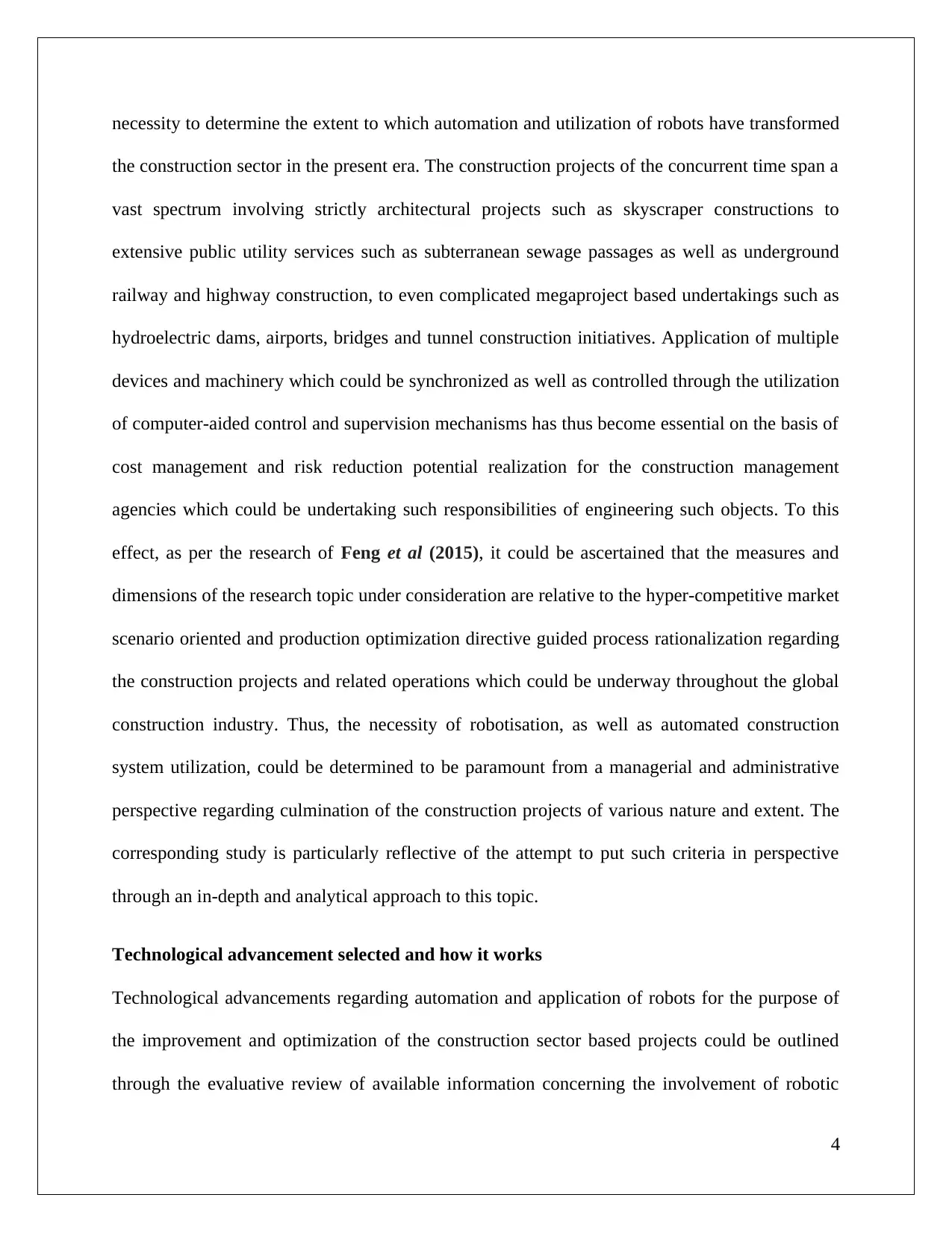
necessity to determine the extent to which automation and utilization of robots have transformed
the construction sector in the present era. The construction projects of the concurrent time span a
vast spectrum involving strictly architectural projects such as skyscraper constructions to
extensive public utility services such as subterranean sewage passages as well as underground
railway and highway construction, to even complicated megaproject based undertakings such as
hydroelectric dams, airports, bridges and tunnel construction initiatives. Application of multiple
devices and machinery which could be synchronized as well as controlled through the utilization
of computer-aided control and supervision mechanisms has thus become essential on the basis of
cost management and risk reduction potential realization for the construction management
agencies which could be undertaking such responsibilities of engineering such objects. To this
effect, as per the research of Feng et al (2015), it could be ascertained that the measures and
dimensions of the research topic under consideration are relative to the hyper-competitive market
scenario oriented and production optimization directive guided process rationalization regarding
the construction projects and related operations which could be underway throughout the global
construction industry. Thus, the necessity of robotisation, as well as automated construction
system utilization, could be determined to be paramount from a managerial and administrative
perspective regarding culmination of the construction projects of various nature and extent. The
corresponding study is particularly reflective of the attempt to put such criteria in perspective
through an in-depth and analytical approach to this topic.
Technological advancement selected and how it works
Technological advancements regarding automation and application of robots for the purpose of
the improvement and optimization of the construction sector based projects could be outlined
through the evaluative review of available information concerning the involvement of robotic
4
the construction sector in the present era. The construction projects of the concurrent time span a
vast spectrum involving strictly architectural projects such as skyscraper constructions to
extensive public utility services such as subterranean sewage passages as well as underground
railway and highway construction, to even complicated megaproject based undertakings such as
hydroelectric dams, airports, bridges and tunnel construction initiatives. Application of multiple
devices and machinery which could be synchronized as well as controlled through the utilization
of computer-aided control and supervision mechanisms has thus become essential on the basis of
cost management and risk reduction potential realization for the construction management
agencies which could be undertaking such responsibilities of engineering such objects. To this
effect, as per the research of Feng et al (2015), it could be ascertained that the measures and
dimensions of the research topic under consideration are relative to the hyper-competitive market
scenario oriented and production optimization directive guided process rationalization regarding
the construction projects and related operations which could be underway throughout the global
construction industry. Thus, the necessity of robotisation, as well as automated construction
system utilization, could be determined to be paramount from a managerial and administrative
perspective regarding culmination of the construction projects of various nature and extent. The
corresponding study is particularly reflective of the attempt to put such criteria in perspective
through an in-depth and analytical approach to this topic.
Technological advancement selected and how it works
Technological advancements regarding automation and application of robots for the purpose of
the improvement and optimization of the construction sector based projects could be outlined
through the evaluative review of available information concerning the involvement of robotic
4
Paraphrase This Document
Need a fresh take? Get an instant paraphrase of this document with our AI Paraphraser
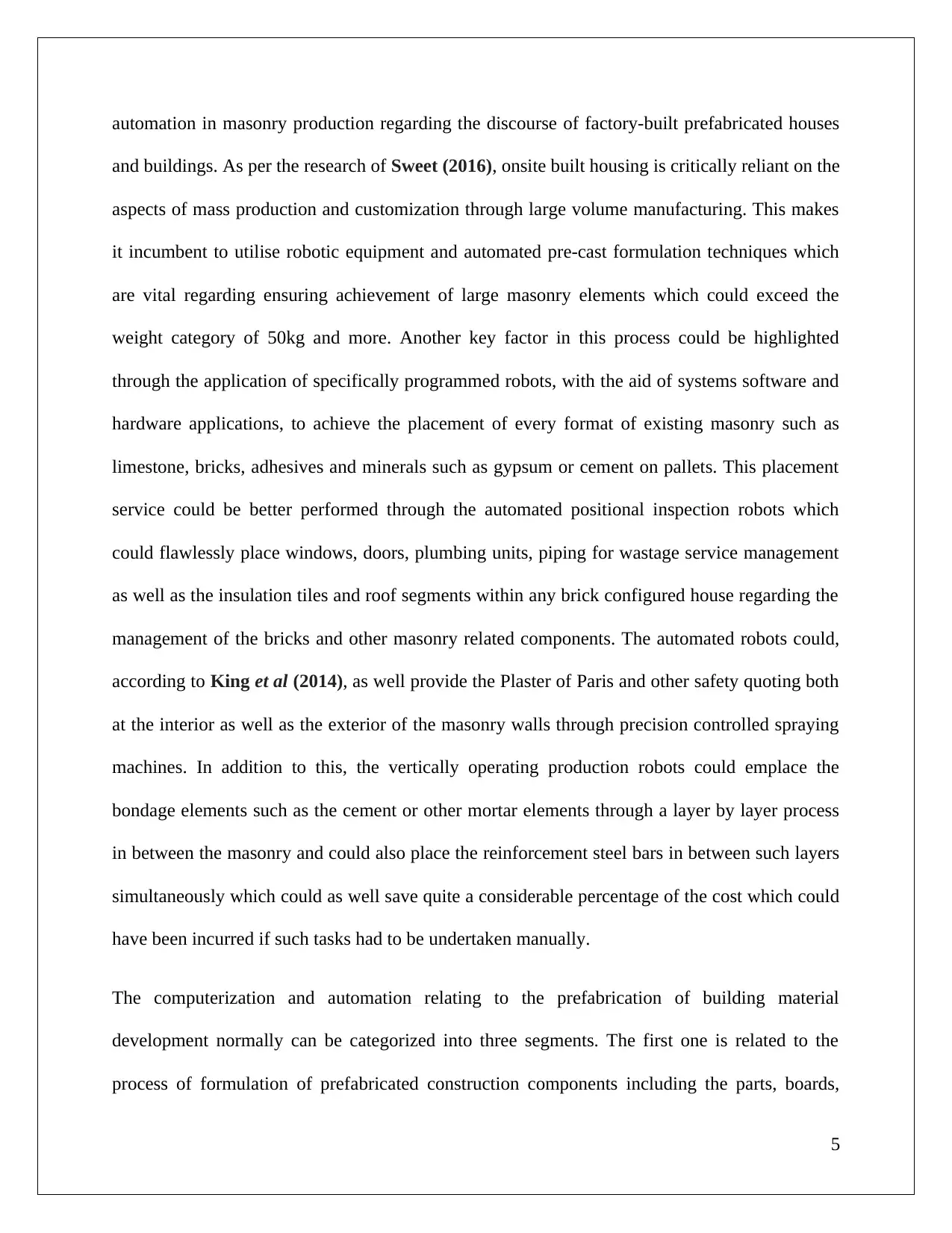
automation in masonry production regarding the discourse of factory-built prefabricated houses
and buildings. As per the research of Sweet (2016), onsite built housing is critically reliant on the
aspects of mass production and customization through large volume manufacturing. This makes
it incumbent to utilise robotic equipment and automated pre-cast formulation techniques which
are vital regarding ensuring achievement of large masonry elements which could exceed the
weight category of 50kg and more. Another key factor in this process could be highlighted
through the application of specifically programmed robots, with the aid of systems software and
hardware applications, to achieve the placement of every format of existing masonry such as
limestone, bricks, adhesives and minerals such as gypsum or cement on pallets. This placement
service could be better performed through the automated positional inspection robots which
could flawlessly place windows, doors, plumbing units, piping for wastage service management
as well as the insulation tiles and roof segments within any brick configured house regarding the
management of the bricks and other masonry related components. The automated robots could,
according to King et al (2014), as well provide the Plaster of Paris and other safety quoting both
at the interior as well as the exterior of the masonry walls through precision controlled spraying
machines. In addition to this, the vertically operating production robots could emplace the
bondage elements such as the cement or other mortar elements through a layer by layer process
in between the masonry and could also place the reinforcement steel bars in between such layers
simultaneously which could as well save quite a considerable percentage of the cost which could
have been incurred if such tasks had to be undertaken manually.
The computerization and automation relating to the prefabrication of building material
development normally can be categorized into three segments. The first one is related to the
process of formulation of prefabricated construction components including the parts, boards,
5
and buildings. As per the research of Sweet (2016), onsite built housing is critically reliant on the
aspects of mass production and customization through large volume manufacturing. This makes
it incumbent to utilise robotic equipment and automated pre-cast formulation techniques which
are vital regarding ensuring achievement of large masonry elements which could exceed the
weight category of 50kg and more. Another key factor in this process could be highlighted
through the application of specifically programmed robots, with the aid of systems software and
hardware applications, to achieve the placement of every format of existing masonry such as
limestone, bricks, adhesives and minerals such as gypsum or cement on pallets. This placement
service could be better performed through the automated positional inspection robots which
could flawlessly place windows, doors, plumbing units, piping for wastage service management
as well as the insulation tiles and roof segments within any brick configured house regarding the
management of the bricks and other masonry related components. The automated robots could,
according to King et al (2014), as well provide the Plaster of Paris and other safety quoting both
at the interior as well as the exterior of the masonry walls through precision controlled spraying
machines. In addition to this, the vertically operating production robots could emplace the
bondage elements such as the cement or other mortar elements through a layer by layer process
in between the masonry and could also place the reinforcement steel bars in between such layers
simultaneously which could as well save quite a considerable percentage of the cost which could
have been incurred if such tasks had to be undertaken manually.
The computerization and automation relating to the prefabrication of building material
development normally can be categorized into three segments. The first one is related to the
process of formulation of prefabricated construction components including the parts, boards,
5
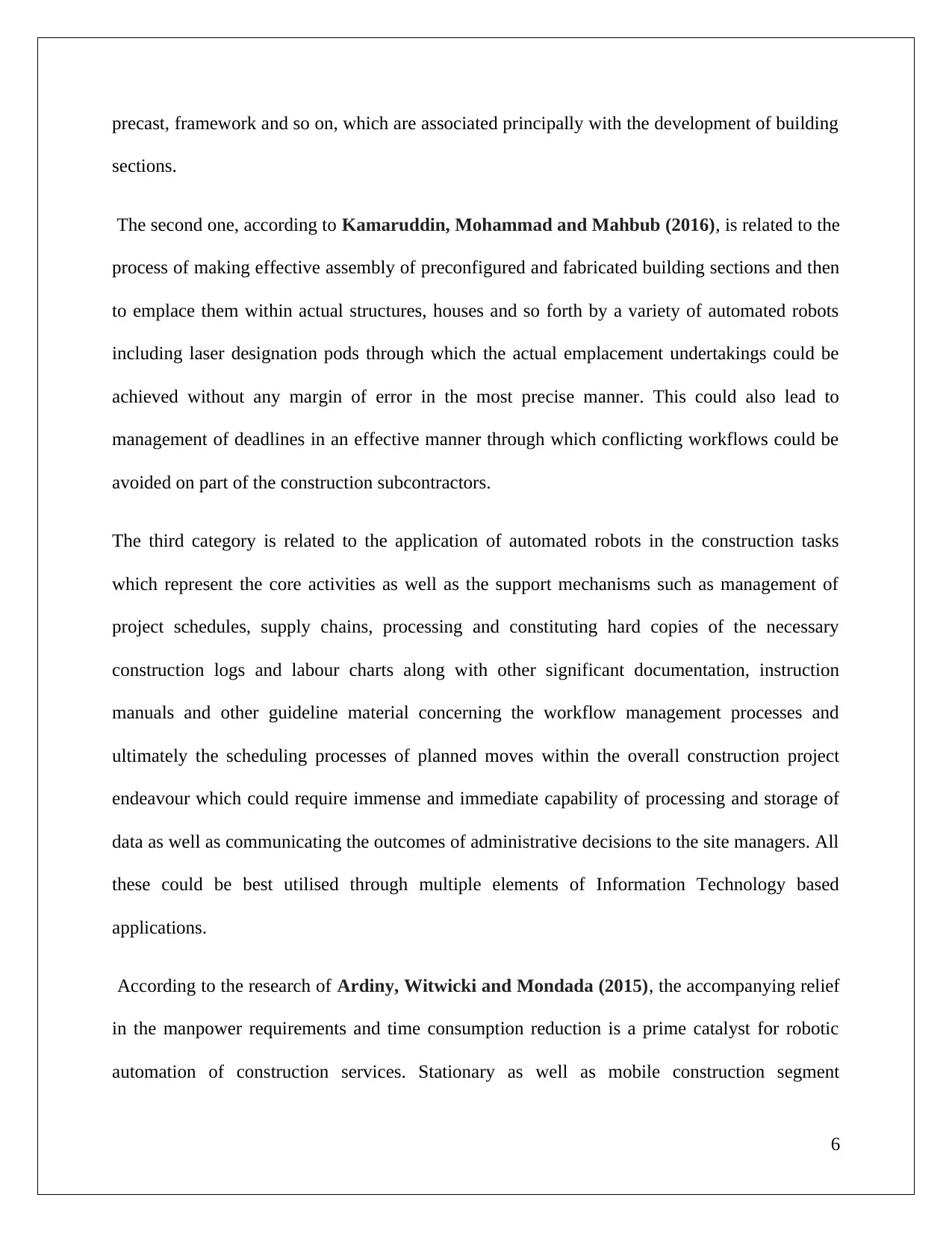
precast, framework and so on, which are associated principally with the development of building
sections.
The second one, according to Kamaruddin, Mohammad and Mahbub (2016), is related to the
process of making effective assembly of preconfigured and fabricated building sections and then
to emplace them within actual structures, houses and so forth by a variety of automated robots
including laser designation pods through which the actual emplacement undertakings could be
achieved without any margin of error in the most precise manner. This could also lead to
management of deadlines in an effective manner through which conflicting workflows could be
avoided on part of the construction subcontractors.
The third category is related to the application of automated robots in the construction tasks
which represent the core activities as well as the support mechanisms such as management of
project schedules, supply chains, processing and constituting hard copies of the necessary
construction logs and labour charts along with other significant documentation, instruction
manuals and other guideline material concerning the workflow management processes and
ultimately the scheduling processes of planned moves within the overall construction project
endeavour which could require immense and immediate capability of processing and storage of
data as well as communicating the outcomes of administrative decisions to the site managers. All
these could be best utilised through multiple elements of Information Technology based
applications.
According to the research of Ardiny, Witwicki and Mondada (2015), the accompanying relief
in the manpower requirements and time consumption reduction is a prime catalyst for robotic
automation of construction services. Stationary as well as mobile construction segment
6
sections.
The second one, according to Kamaruddin, Mohammad and Mahbub (2016), is related to the
process of making effective assembly of preconfigured and fabricated building sections and then
to emplace them within actual structures, houses and so forth by a variety of automated robots
including laser designation pods through which the actual emplacement undertakings could be
achieved without any margin of error in the most precise manner. This could also lead to
management of deadlines in an effective manner through which conflicting workflows could be
avoided on part of the construction subcontractors.
The third category is related to the application of automated robots in the construction tasks
which represent the core activities as well as the support mechanisms such as management of
project schedules, supply chains, processing and constituting hard copies of the necessary
construction logs and labour charts along with other significant documentation, instruction
manuals and other guideline material concerning the workflow management processes and
ultimately the scheduling processes of planned moves within the overall construction project
endeavour which could require immense and immediate capability of processing and storage of
data as well as communicating the outcomes of administrative decisions to the site managers. All
these could be best utilised through multiple elements of Information Technology based
applications.
According to the research of Ardiny, Witwicki and Mondada (2015), the accompanying relief
in the manpower requirements and time consumption reduction is a prime catalyst for robotic
automation of construction services. Stationary as well as mobile construction segment
6
⊘ This is a preview!⊘
Do you want full access?
Subscribe today to unlock all pages.

Trusted by 1+ million students worldwide
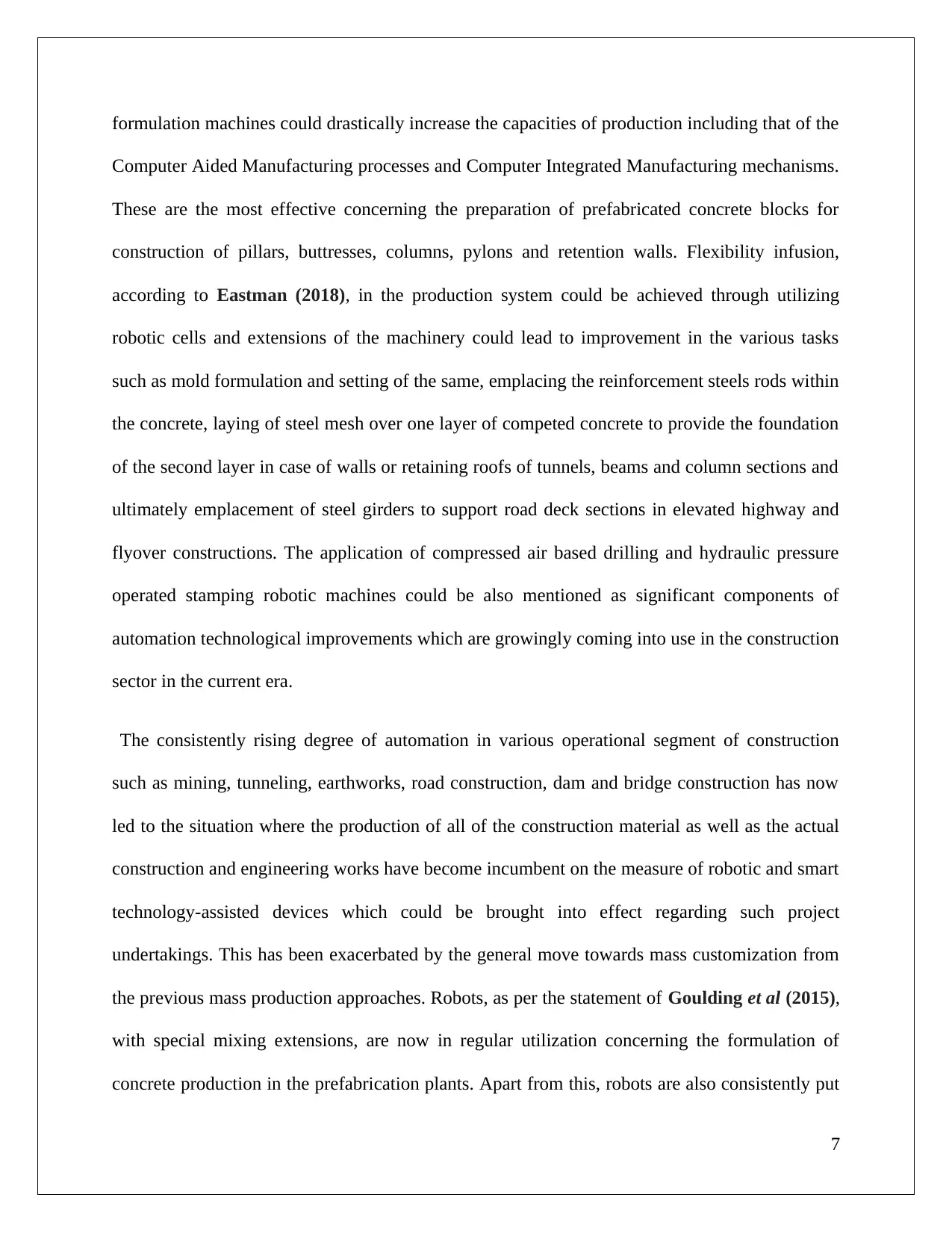
formulation machines could drastically increase the capacities of production including that of the
Computer Aided Manufacturing processes and Computer Integrated Manufacturing mechanisms.
These are the most effective concerning the preparation of prefabricated concrete blocks for
construction of pillars, buttresses, columns, pylons and retention walls. Flexibility infusion,
according to Eastman (2018), in the production system could be achieved through utilizing
robotic cells and extensions of the machinery could lead to improvement in the various tasks
such as mold formulation and setting of the same, emplacing the reinforcement steels rods within
the concrete, laying of steel mesh over one layer of competed concrete to provide the foundation
of the second layer in case of walls or retaining roofs of tunnels, beams and column sections and
ultimately emplacement of steel girders to support road deck sections in elevated highway and
flyover constructions. The application of compressed air based drilling and hydraulic pressure
operated stamping robotic machines could be also mentioned as significant components of
automation technological improvements which are growingly coming into use in the construction
sector in the current era.
The consistently rising degree of automation in various operational segment of construction
such as mining, tunneling, earthworks, road construction, dam and bridge construction has now
led to the situation where the production of all of the construction material as well as the actual
construction and engineering works have become incumbent on the measure of robotic and smart
technology-assisted devices which could be brought into effect regarding such project
undertakings. This has been exacerbated by the general move towards mass customization from
the previous mass production approaches. Robots, as per the statement of Goulding et al (2015),
with special mixing extensions, are now in regular utilization concerning the formulation of
concrete production in the prefabrication plants. Apart from this, robots are also consistently put
7
Computer Aided Manufacturing processes and Computer Integrated Manufacturing mechanisms.
These are the most effective concerning the preparation of prefabricated concrete blocks for
construction of pillars, buttresses, columns, pylons and retention walls. Flexibility infusion,
according to Eastman (2018), in the production system could be achieved through utilizing
robotic cells and extensions of the machinery could lead to improvement in the various tasks
such as mold formulation and setting of the same, emplacing the reinforcement steels rods within
the concrete, laying of steel mesh over one layer of competed concrete to provide the foundation
of the second layer in case of walls or retaining roofs of tunnels, beams and column sections and
ultimately emplacement of steel girders to support road deck sections in elevated highway and
flyover constructions. The application of compressed air based drilling and hydraulic pressure
operated stamping robotic machines could be also mentioned as significant components of
automation technological improvements which are growingly coming into use in the construction
sector in the current era.
The consistently rising degree of automation in various operational segment of construction
such as mining, tunneling, earthworks, road construction, dam and bridge construction has now
led to the situation where the production of all of the construction material as well as the actual
construction and engineering works have become incumbent on the measure of robotic and smart
technology-assisted devices which could be brought into effect regarding such project
undertakings. This has been exacerbated by the general move towards mass customization from
the previous mass production approaches. Robots, as per the statement of Goulding et al (2015),
with special mixing extensions, are now in regular utilization concerning the formulation of
concrete production in the prefabrication plants. Apart from this, robots are also consistently put
7
Paraphrase This Document
Need a fresh take? Get an instant paraphrase of this document with our AI Paraphraser
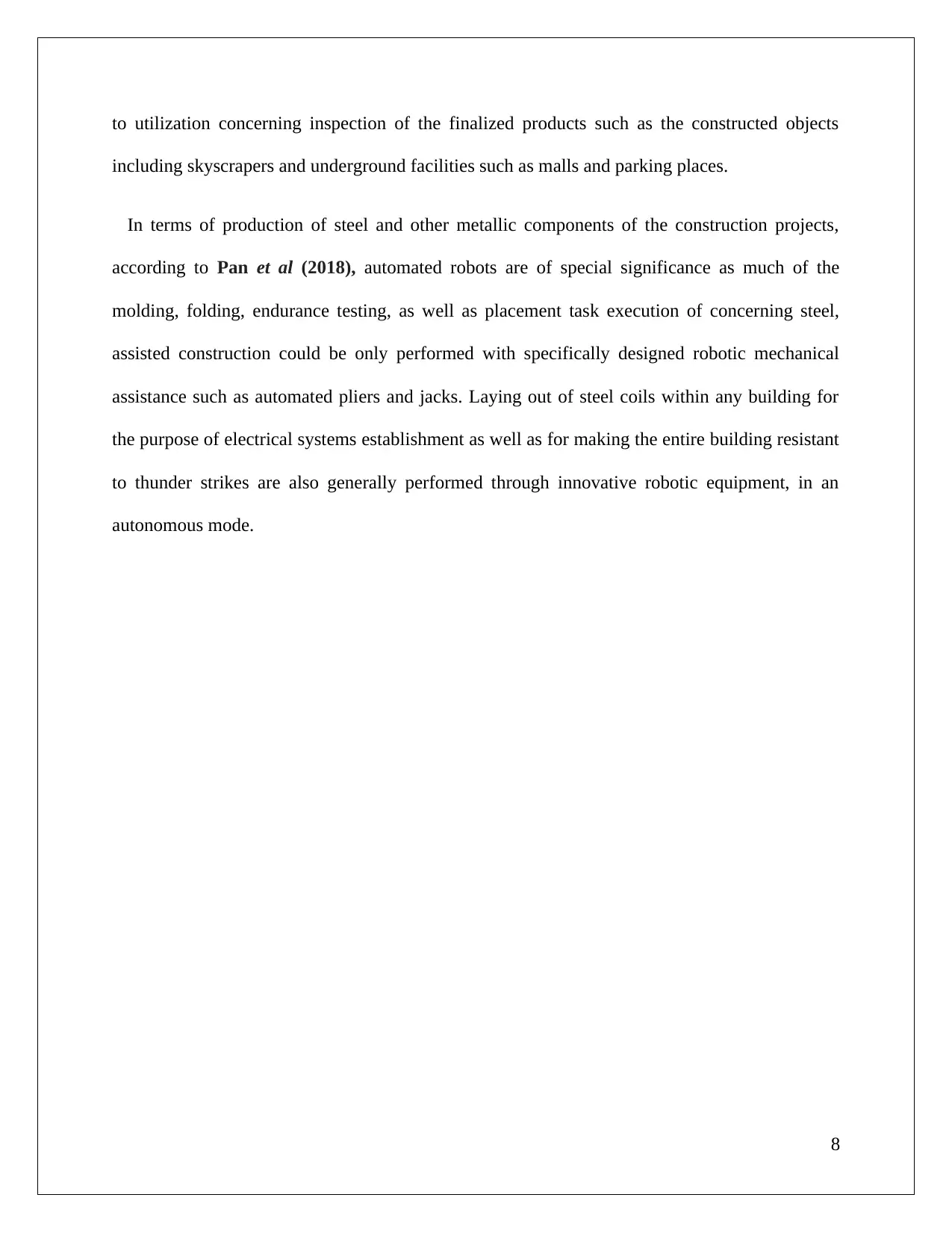
to utilization concerning inspection of the finalized products such as the constructed objects
including skyscrapers and underground facilities such as malls and parking places.
In terms of production of steel and other metallic components of the construction projects,
according to Pan et al (2018), automated robots are of special significance as much of the
molding, folding, endurance testing, as well as placement task execution of concerning steel,
assisted construction could be only performed with specifically designed robotic mechanical
assistance such as automated pliers and jacks. Laying out of steel coils within any building for
the purpose of electrical systems establishment as well as for making the entire building resistant
to thunder strikes are also generally performed through innovative robotic equipment, in an
autonomous mode.
8
including skyscrapers and underground facilities such as malls and parking places.
In terms of production of steel and other metallic components of the construction projects,
according to Pan et al (2018), automated robots are of special significance as much of the
molding, folding, endurance testing, as well as placement task execution of concerning steel,
assisted construction could be only performed with specifically designed robotic mechanical
assistance such as automated pliers and jacks. Laying out of steel coils within any building for
the purpose of electrical systems establishment as well as for making the entire building resistant
to thunder strikes are also generally performed through innovative robotic equipment, in an
autonomous mode.
8
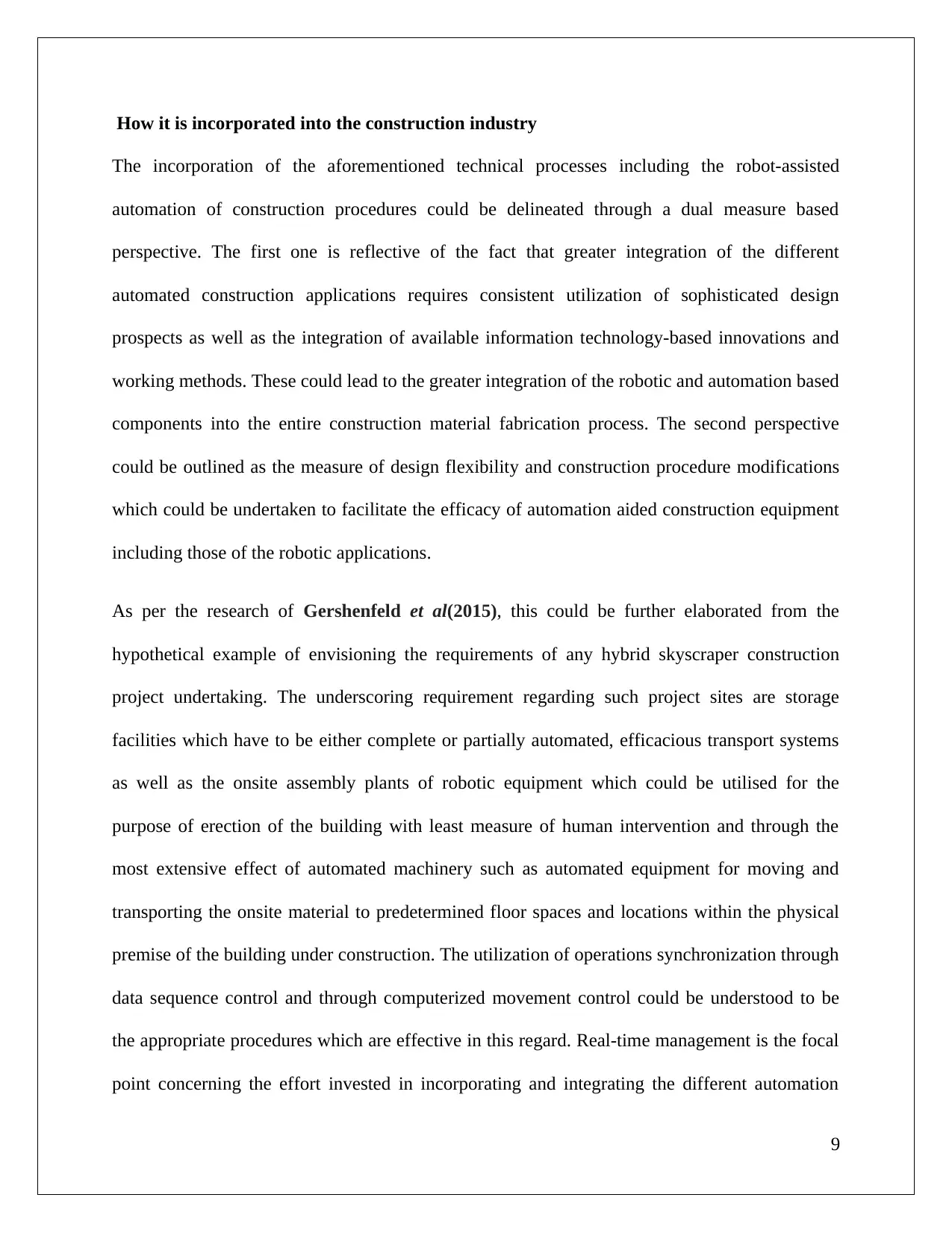
How it is incorporated into the construction industry
The incorporation of the aforementioned technical processes including the robot-assisted
automation of construction procedures could be delineated through a dual measure based
perspective. The first one is reflective of the fact that greater integration of the different
automated construction applications requires consistent utilization of sophisticated design
prospects as well as the integration of available information technology-based innovations and
working methods. These could lead to the greater integration of the robotic and automation based
components into the entire construction material fabrication process. The second perspective
could be outlined as the measure of design flexibility and construction procedure modifications
which could be undertaken to facilitate the efficacy of automation aided construction equipment
including those of the robotic applications.
As per the research of Gershenfeld et al(2015), this could be further elaborated from the
hypothetical example of envisioning the requirements of any hybrid skyscraper construction
project undertaking. The underscoring requirement regarding such project sites are storage
facilities which have to be either complete or partially automated, efficacious transport systems
as well as the onsite assembly plants of robotic equipment which could be utilised for the
purpose of erection of the building with least measure of human intervention and through the
most extensive effect of automated machinery such as automated equipment for moving and
transporting the onsite material to predetermined floor spaces and locations within the physical
premise of the building under construction. The utilization of operations synchronization through
data sequence control and through computerized movement control could be understood to be
the appropriate procedures which are effective in this regard. Real-time management is the focal
point concerning the effort invested in incorporating and integrating the different automation
9
The incorporation of the aforementioned technical processes including the robot-assisted
automation of construction procedures could be delineated through a dual measure based
perspective. The first one is reflective of the fact that greater integration of the different
automated construction applications requires consistent utilization of sophisticated design
prospects as well as the integration of available information technology-based innovations and
working methods. These could lead to the greater integration of the robotic and automation based
components into the entire construction material fabrication process. The second perspective
could be outlined as the measure of design flexibility and construction procedure modifications
which could be undertaken to facilitate the efficacy of automation aided construction equipment
including those of the robotic applications.
As per the research of Gershenfeld et al(2015), this could be further elaborated from the
hypothetical example of envisioning the requirements of any hybrid skyscraper construction
project undertaking. The underscoring requirement regarding such project sites are storage
facilities which have to be either complete or partially automated, efficacious transport systems
as well as the onsite assembly plants of robotic equipment which could be utilised for the
purpose of erection of the building with least measure of human intervention and through the
most extensive effect of automated machinery such as automated equipment for moving and
transporting the onsite material to predetermined floor spaces and locations within the physical
premise of the building under construction. The utilization of operations synchronization through
data sequence control and through computerized movement control could be understood to be
the appropriate procedures which are effective in this regard. Real-time management is the focal
point concerning the effort invested in incorporating and integrating the different automation
9
⊘ This is a preview!⊘
Do you want full access?
Subscribe today to unlock all pages.

Trusted by 1+ million students worldwide
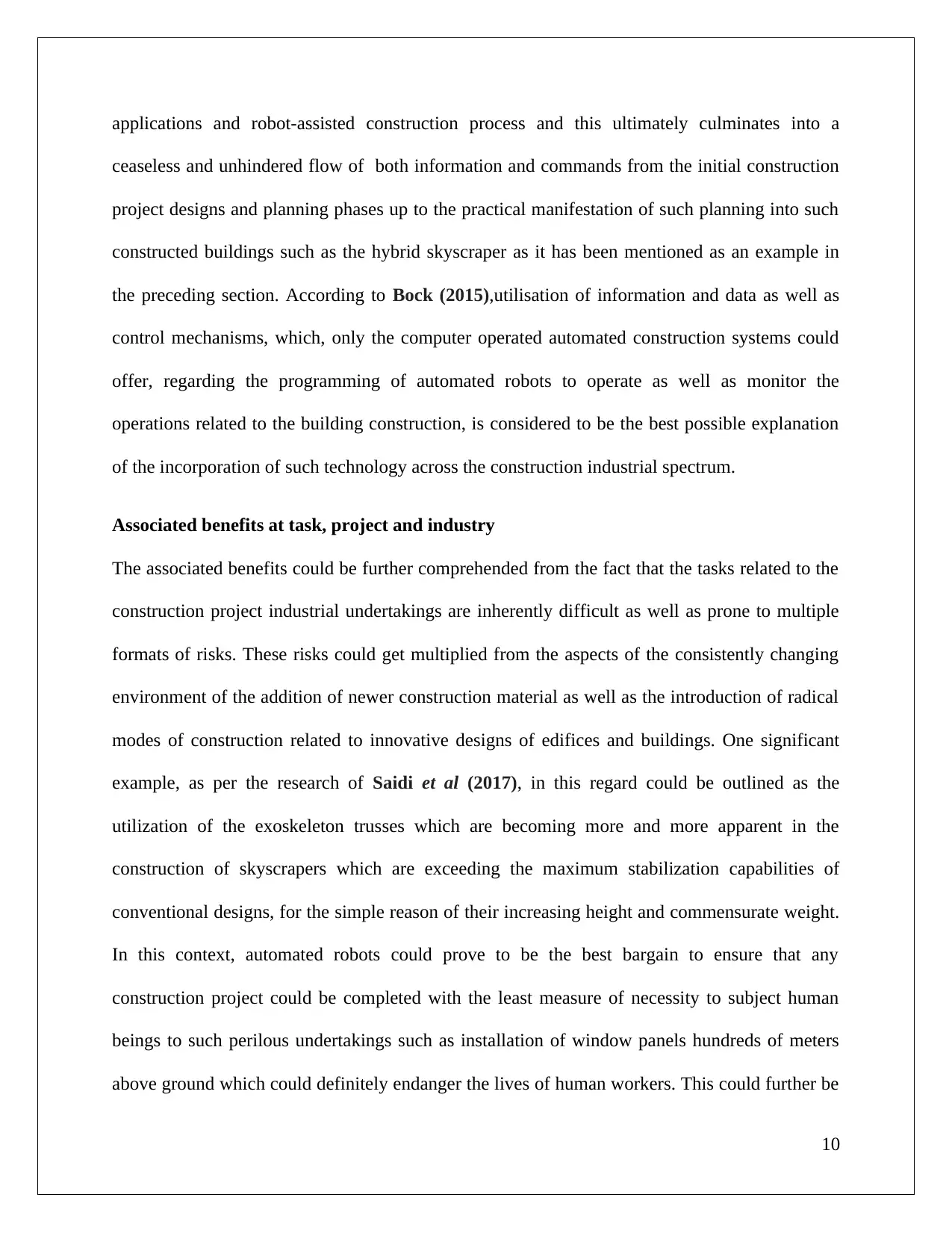
applications and robot-assisted construction process and this ultimately culminates into a
ceaseless and unhindered flow of both information and commands from the initial construction
project designs and planning phases up to the practical manifestation of such planning into such
constructed buildings such as the hybrid skyscraper as it has been mentioned as an example in
the preceding section. According to Bock (2015),utilisation of information and data as well as
control mechanisms, which, only the computer operated automated construction systems could
offer, regarding the programming of automated robots to operate as well as monitor the
operations related to the building construction, is considered to be the best possible explanation
of the incorporation of such technology across the construction industrial spectrum.
Associated benefits at task, project and industry
The associated benefits could be further comprehended from the fact that the tasks related to the
construction project industrial undertakings are inherently difficult as well as prone to multiple
formats of risks. These risks could get multiplied from the aspects of the consistently changing
environment of the addition of newer construction material as well as the introduction of radical
modes of construction related to innovative designs of edifices and buildings. One significant
example, as per the research of Saidi et al (2017), in this regard could be outlined as the
utilization of the exoskeleton trusses which are becoming more and more apparent in the
construction of skyscrapers which are exceeding the maximum stabilization capabilities of
conventional designs, for the simple reason of their increasing height and commensurate weight.
In this context, automated robots could prove to be the best bargain to ensure that any
construction project could be completed with the least measure of necessity to subject human
beings to such perilous undertakings such as installation of window panels hundreds of meters
above ground which could definitely endanger the lives of human workers. This could further be
10
ceaseless and unhindered flow of both information and commands from the initial construction
project designs and planning phases up to the practical manifestation of such planning into such
constructed buildings such as the hybrid skyscraper as it has been mentioned as an example in
the preceding section. According to Bock (2015),utilisation of information and data as well as
control mechanisms, which, only the computer operated automated construction systems could
offer, regarding the programming of automated robots to operate as well as monitor the
operations related to the building construction, is considered to be the best possible explanation
of the incorporation of such technology across the construction industrial spectrum.
Associated benefits at task, project and industry
The associated benefits could be further comprehended from the fact that the tasks related to the
construction project industrial undertakings are inherently difficult as well as prone to multiple
formats of risks. These risks could get multiplied from the aspects of the consistently changing
environment of the addition of newer construction material as well as the introduction of radical
modes of construction related to innovative designs of edifices and buildings. One significant
example, as per the research of Saidi et al (2017), in this regard could be outlined as the
utilization of the exoskeleton trusses which are becoming more and more apparent in the
construction of skyscrapers which are exceeding the maximum stabilization capabilities of
conventional designs, for the simple reason of their increasing height and commensurate weight.
In this context, automated robots could prove to be the best bargain to ensure that any
construction project could be completed with the least measure of necessity to subject human
beings to such perilous undertakings such as installation of window panels hundreds of meters
above ground which could definitely endanger the lives of human workers. This could further be
10
Paraphrase This Document
Need a fresh take? Get an instant paraphrase of this document with our AI Paraphraser
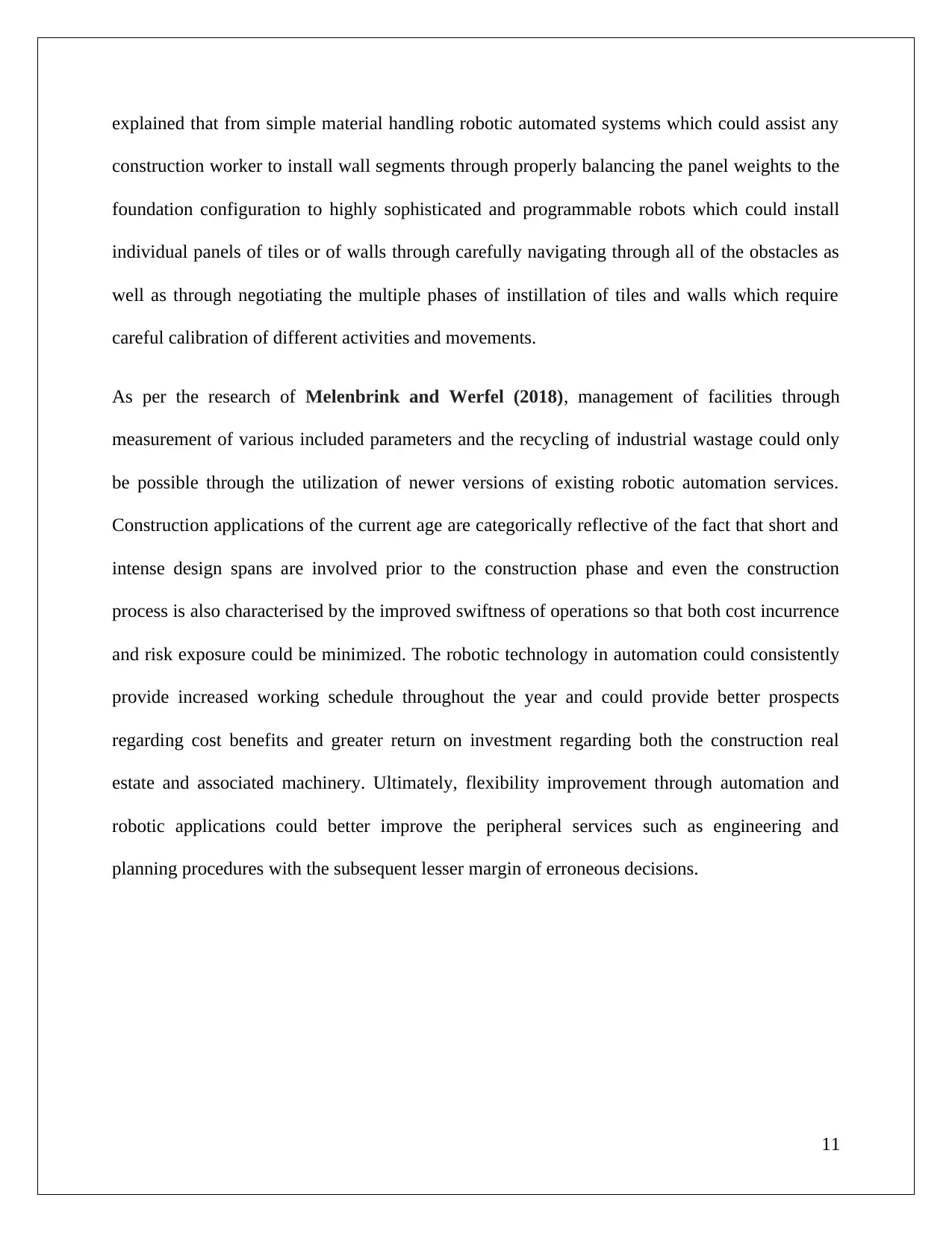
explained that from simple material handling robotic automated systems which could assist any
construction worker to install wall segments through properly balancing the panel weights to the
foundation configuration to highly sophisticated and programmable robots which could install
individual panels of tiles or of walls through carefully navigating through all of the obstacles as
well as through negotiating the multiple phases of instillation of tiles and walls which require
careful calibration of different activities and movements.
As per the research of Melenbrink and Werfel (2018), management of facilities through
measurement of various included parameters and the recycling of industrial wastage could only
be possible through the utilization of newer versions of existing robotic automation services.
Construction applications of the current age are categorically reflective of the fact that short and
intense design spans are involved prior to the construction phase and even the construction
process is also characterised by the improved swiftness of operations so that both cost incurrence
and risk exposure could be minimized. The robotic technology in automation could consistently
provide increased working schedule throughout the year and could provide better prospects
regarding cost benefits and greater return on investment regarding both the construction real
estate and associated machinery. Ultimately, flexibility improvement through automation and
robotic applications could better improve the peripheral services such as engineering and
planning procedures with the subsequent lesser margin of erroneous decisions.
11
construction worker to install wall segments through properly balancing the panel weights to the
foundation configuration to highly sophisticated and programmable robots which could install
individual panels of tiles or of walls through carefully navigating through all of the obstacles as
well as through negotiating the multiple phases of instillation of tiles and walls which require
careful calibration of different activities and movements.
As per the research of Melenbrink and Werfel (2018), management of facilities through
measurement of various included parameters and the recycling of industrial wastage could only
be possible through the utilization of newer versions of existing robotic automation services.
Construction applications of the current age are categorically reflective of the fact that short and
intense design spans are involved prior to the construction phase and even the construction
process is also characterised by the improved swiftness of operations so that both cost incurrence
and risk exposure could be minimized. The robotic technology in automation could consistently
provide increased working schedule throughout the year and could provide better prospects
regarding cost benefits and greater return on investment regarding both the construction real
estate and associated machinery. Ultimately, flexibility improvement through automation and
robotic applications could better improve the peripheral services such as engineering and
planning procedures with the subsequent lesser margin of erroneous decisions.
11
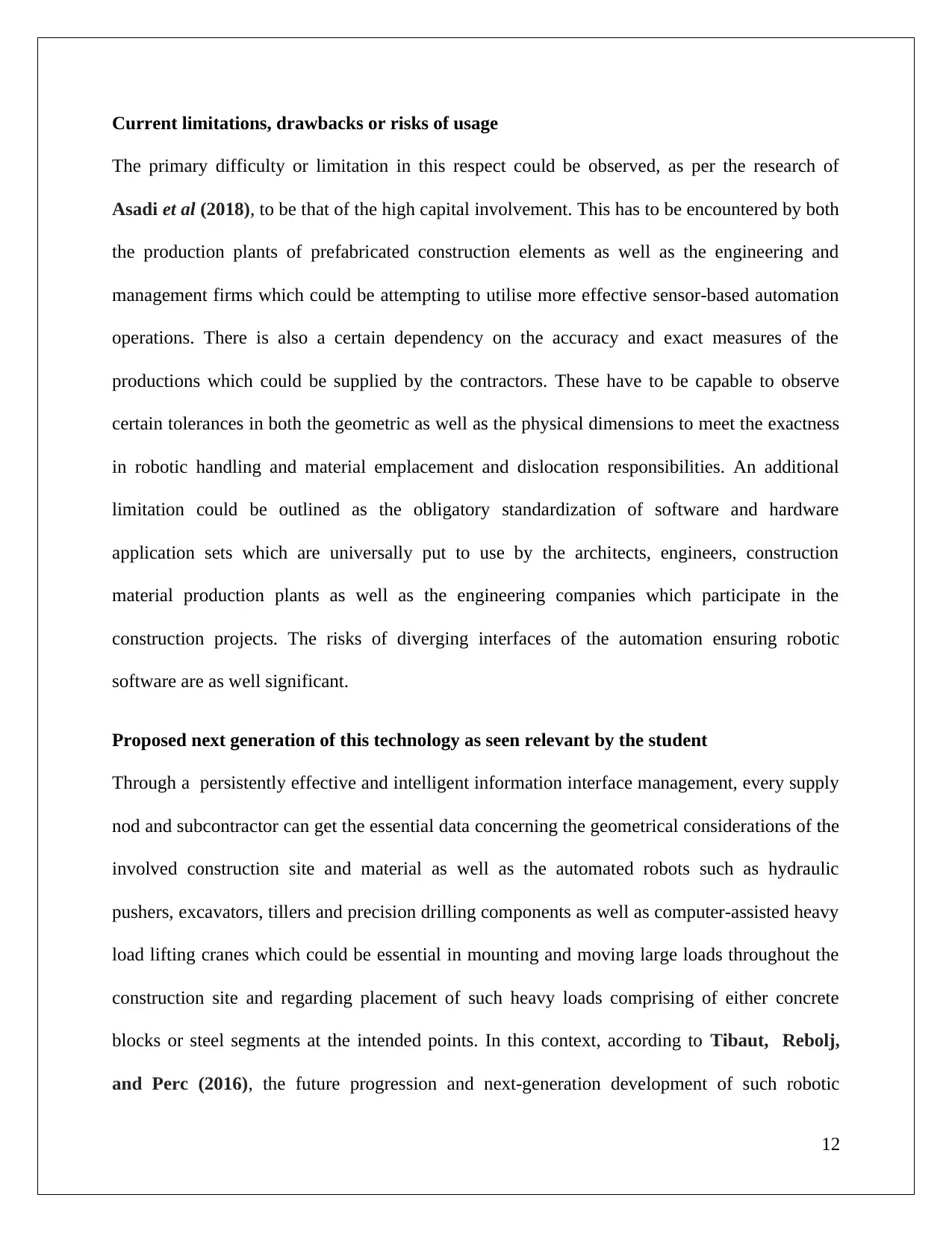
Current limitations, drawbacks or risks of usage
The primary difficulty or limitation in this respect could be observed, as per the research of
Asadi et al (2018), to be that of the high capital involvement. This has to be encountered by both
the production plants of prefabricated construction elements as well as the engineering and
management firms which could be attempting to utilise more effective sensor-based automation
operations. There is also a certain dependency on the accuracy and exact measures of the
productions which could be supplied by the contractors. These have to be capable to observe
certain tolerances in both the geometric as well as the physical dimensions to meet the exactness
in robotic handling and material emplacement and dislocation responsibilities. An additional
limitation could be outlined as the obligatory standardization of software and hardware
application sets which are universally put to use by the architects, engineers, construction
material production plants as well as the engineering companies which participate in the
construction projects. The risks of diverging interfaces of the automation ensuring robotic
software are as well significant.
Proposed next generation of this technology as seen relevant by the student
Through a persistently effective and intelligent information interface management, every supply
nod and subcontractor can get the essential data concerning the geometrical considerations of the
involved construction site and material as well as the automated robots such as hydraulic
pushers, excavators, tillers and precision drilling components as well as computer-assisted heavy
load lifting cranes which could be essential in mounting and moving large loads throughout the
construction site and regarding placement of such heavy loads comprising of either concrete
blocks or steel segments at the intended points. In this context, according to Tibaut, Rebolj,
and Perc (2016), the future progression and next-generation development of such robotic
12
The primary difficulty or limitation in this respect could be observed, as per the research of
Asadi et al (2018), to be that of the high capital involvement. This has to be encountered by both
the production plants of prefabricated construction elements as well as the engineering and
management firms which could be attempting to utilise more effective sensor-based automation
operations. There is also a certain dependency on the accuracy and exact measures of the
productions which could be supplied by the contractors. These have to be capable to observe
certain tolerances in both the geometric as well as the physical dimensions to meet the exactness
in robotic handling and material emplacement and dislocation responsibilities. An additional
limitation could be outlined as the obligatory standardization of software and hardware
application sets which are universally put to use by the architects, engineers, construction
material production plants as well as the engineering companies which participate in the
construction projects. The risks of diverging interfaces of the automation ensuring robotic
software are as well significant.
Proposed next generation of this technology as seen relevant by the student
Through a persistently effective and intelligent information interface management, every supply
nod and subcontractor can get the essential data concerning the geometrical considerations of the
involved construction site and material as well as the automated robots such as hydraulic
pushers, excavators, tillers and precision drilling components as well as computer-assisted heavy
load lifting cranes which could be essential in mounting and moving large loads throughout the
construction site and regarding placement of such heavy loads comprising of either concrete
blocks or steel segments at the intended points. In this context, according to Tibaut, Rebolj,
and Perc (2016), the future progression and next-generation development of such robotic
12
⊘ This is a preview!⊘
Do you want full access?
Subscribe today to unlock all pages.

Trusted by 1+ million students worldwide
1 out of 17
Related Documents
Your All-in-One AI-Powered Toolkit for Academic Success.
+13062052269
info@desklib.com
Available 24*7 on WhatsApp / Email
![[object Object]](/_next/static/media/star-bottom.7253800d.svg)
Unlock your academic potential
Copyright © 2020–2025 A2Z Services. All Rights Reserved. Developed and managed by ZUCOL.





